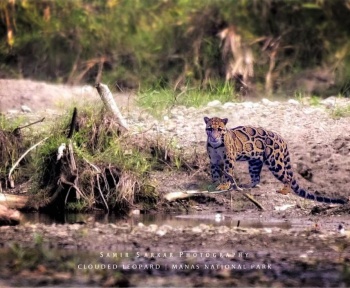Manas wildlife sanctuary, a biodiversity hotspot is located in Assam of northeast India. The site’s magnificence involves forested slopes, alluvial fields, and forests. It is the home for many rare and endangered species like the Bengal Tiger, Clouded Leopard, Black Panther, Swamp deer, Hispid hare, one-horned rhino, and Bengal florican.
Manas has an outstanding significance in India as the main leftover normal region with many threatened species. One among the many endangered species is Hispid hare.
Hispid hare is also known as Assam rabbit, bristly rabbit. It belongs to the order Lagomorpha, family Leporidae, and genus Caprolagus with a single species hispid hare. It is scientifically known as Caprolagus hispidus.
The first attempt to study the present status and distribution of hispid hare was made in 2008-2009. It was conducted within the north bank landscape (in protected areas of Assam and Arunachal Pradesh) of northeast India.
To identify the present population of the hispid hare and their distribution, and an ecological survey was conducted in the tall grasslands of Manas National Park. The main objectives of the study were to find the present status and distribution, different types of grasslands with different patterns, identify the threats, preparation of distribution maps using GIS techniques, create awareness among the local population, designate local conservation volunteers, and ground-level forest staff.
The lagomorphs have worldwide distribution extending from the equator to 80 degrees north, from sea level to 5000m in mountains, from desert to tropical forest. 90 living species are there consisting of 29 pikas, 32 hares, and 29 rabbits. The order Lagomorpha is distributed in 2 families namely Ochotonidae and Leporidae. Both the families are easily identified by their characteristic morphological features.
The members of Ochotonidae (pikas) have long wide and rounded ears, a skull with no supraorbital bones, and a relatively short nasal region. the forelegs are comparatively longer than the hindlegs. The members of Leporidae have long ears, a skull with prominent supraorbital bones, and a long nasal region. The hind legs are longer than the forelegs.
Evolution and classification –
The hispid hare has dark brown hair, short broad ears (approx. 56mm), small eyes, and large teeth. The front legs are larger than the back legs with straight and strong claws. It has two layers of fur- the rough, bristly outer layer and fine, short under layer. The rough, bristly coat has a mixed black and brownish white hair giving a dark brown dorsal surface. The ventral surface is brown on the chest and white on the abdomen. The tail is brown and short (approx. 56mm).
The average weight is around 2248g for males and 2518g for females. The length ranges from 405 to 538mm.
The beauty of hispid hare can’t be explained by the words. To cherish them go for a daring trip with Manas National Park wildlife photography tour and create memories of your lifetime.
Habitat –
Hispid hare lives in early successional tall grasslands (commonly known as elephant grass) with their homes covering a mean area of 8200sq.m for males and 2800sq.m for females.
The tall grasslands form the understorey during the later stages of succession, forest clearings, and the abandoned cultivation.
They live in pairs and the total home range of males is more than that of females. During the early months of the year (January to April) when the grasslands and forests are set on fire, they move to the fields and on the banks of the dried up stream.
During the peak season of the Monsoon the hare moves to the forested areas of the foothills. The hispid hare does not construct its burrow. It lives on the burrows made by other animals.
Distribution –
In the past years, hispid hares had a wide range of extensions from Uttar Pradesh through southern Nepal, the north of West Bengal to Assam, Bangladesh.
Hispid hare is found in various wildlife sanctuaries namely wildlife sanctuary in Assam, Jaldapara wildlife sanctuary, Buxa Tiger reserve in west Bengal, Dudwa National Park in the Kheri district of Uttar Pradesh, Chitwan National park, Valmiki wildlife sanctuary (west Champaran district), Bihar, Kanha National park (Madhya Pradesh), Bardia wildlife reserve and Suklaphanta Wildlife Reserve in the Terai region of southern and southwestern Nepal.
Food Habits –
Hispid hare is an herbivorous animal. They feed on crops, grassroots, shoot, and bark.
Behavior & Production –
Hispid hare resembles more of a rabbit both by structure and behavior. They are slow-moving nocturnal animals. There is no much information about mating. The species is monogamous and breeds during the winter. The breeding interval is about 1-2 per year. The breeding season is around late winter or early spring. The gestational period lasts for 25-50 days. The average litter size is about 2-9 per year. They give birth to the young ones between January to march. The females are polyestrous and can give birth to multiple litters per year. The male hare provides no parental care to the young ones while the female hare cares little by feeding their young ones for five minutes a day.
Communication –
Not much is known about communication because of their rare existence. Most rabbits and hares use foot drumming as a means of communication. It is commonly known that all rabbits and hares secrete fragrance from the glands in their groin and from a gland under the chin which is used for sexual communication by the mates. Since it is a mammal we can infer that they use visual signals and tactile communication to communicate with their mates, between mother and the offspring.
Conservation Status –
The hispid hare is one of the two lagomorphs which are listed in the CITES and IUCN red list as the endangered species. Hispid hare (Caprolagus hispidus) has been cited in schedule 1 of the Indian wildlife protection act, 1972 as it has the threat of extinction.
They are becoming endangered because of overgrazing, agriculture, hunting activities, thatch grass cutting, conversion of grasslands into woodlands, and invasion by the weeds.
Now the world population of hispid hares is believed to be below 300 individuals restricted mainly to Assam and Jaldapara.
We, humans, are destroying nature in the name of human development. But we need to remember that our mother earth is not only home for humans but also trees, birds, and animals. We have to preserve them. These photographs can be used as a tool to create awareness for the people.
Go fast and get ready with your travel bags and camera to explore the beauty of Manas tiger reserve and Manas wildlife sanctuary with the best wildlife safaris in India.



